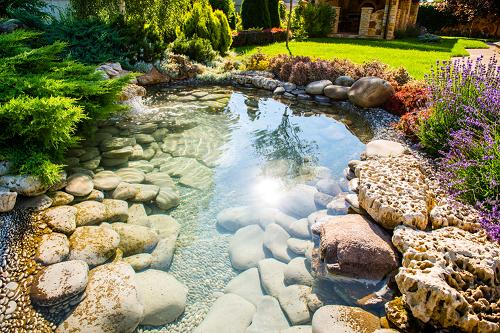Spruce Up Your Outdoor Landscape with A Rock Garden
Designing your landscape creates an aesthetically appealing ambiance and a sense of satisfaction in your home. One practical way to achieve a satisfying design is by adding a rock garden to your yard. Rockeries, also known as alpine gardens, add texture, beauty, and color to a home, and require minimal attention. These type of gardens emphasizes a variety of rocks, stones, and boulders and incorporate small plants and shrubs to add a contrasting green effect.
Why Should You Choose a Rockery?

ckeries can withstand harsh weather as compared to greener gardens. Even without rain, your rocks will remain sturdy, unlike green plants that wither away. If you live in drier zones, rockeries are suitable because they contribute to water conservation, while still providing beauty to your home. A rockery will also cut down your maintenance time by eliminating tasks such as weeding, watering plants, and pruning flowers. Lastly, no matter how small your compound is, a rockery will fit and add to the diversity of your landscape without overcrowding your yard.
How to Create Your Rock Garden
The concept of rockeries is to recreate the features naturally existing in your yard. If your landscape is naturally rocky, then you can use the rocks in your compound. If not, should invest in sound design and materials to achieve drainage and aesthetics.
- Sketch Out Your Plan
Map out the idea of your garden using a pencil and paper. Sketching your alpine garden will save you time once you start laying the rocks and plants. It will also ensure you acquire all materials before creating the garden.
- Take Out the Weeds
Rockeries are appealing when all stones and vegetation exist harmoniously. When weeds crop up between boulders, your garden becomes unruly, which is why you should start by weeding your yard. Ensure that you pull out all unwanted vegetation by the roots or apply herbicide a few weeks before laying your garden.
- Drainage
Once you have cleared out the vegetation, dig out at least 60cm of soil in well-drained areas, or one meter if you live in a clay region. Backfill with well-drained material such as rubble, hardcore, stone chippings, and coarse sand. After backfilling, add bone meal, manure or compost to the landscape to promote plant growth.
- Choose Your Rocks
Your choice of rocks is entirely dependent on your design. Smooth stones are suitable for gardens with water features and ponds. Alternatively, you can use large boulders as a focal point by laying small rocks around them. You can also use colored stones to create mosaics and create contrast in your garden. If you have a sloping landscape, consider creating a terraced landscape featuring plants in between the terraces and a rocky path down the hill.
- Choose Your Plants
Alpine gardens work best with small plants and bushes that can survive in shallow soils. Go for alpine-origin vegetation and drought-resistant plants. Daffodils, tulips, brodiaea are tiny and add color to the garden. If you are recreating a Japanese Zen garden, focus on pruned bushes and moss. However, if you live in an arid region, opt for succulent plants spaced evenly between the rocks.
- Incorporate Pottery or a Water Feature
Pottery is an effective way to add color to your garden while still creating space for plants. If your landscape is extremely rocky, pots are a cost-effective method of adding vegetation to the yard. You can add a pond or a small waterfall to spice up the garden. The sound of water cascading down your rock formation adds a sense of serenity.
Conclusion
Rockeries are a great way to improve your yard and bring a peaceful meditative ambiance to your home. With the right help, you can create the perfect rockery for your home. If you are looking for professional help with your rock garden, contact us today.
Both comments and pings are currently closed.





